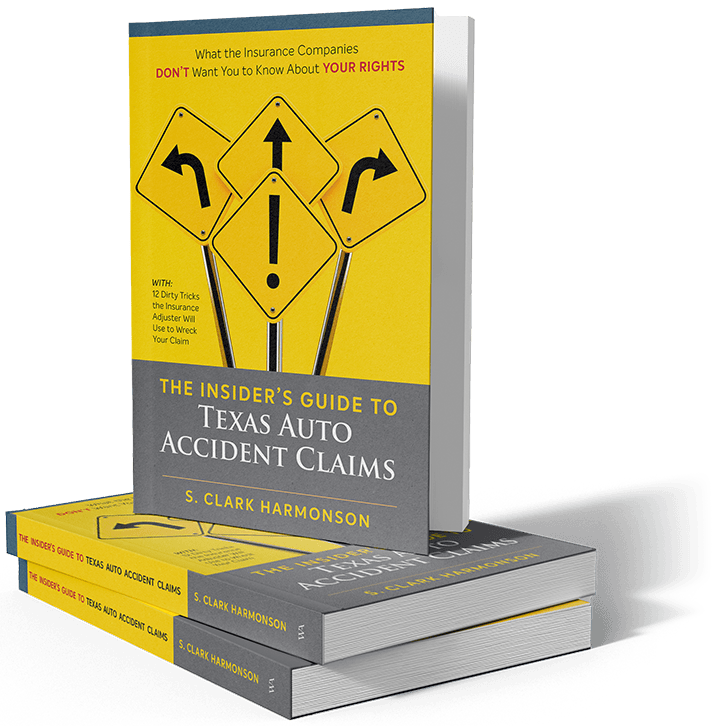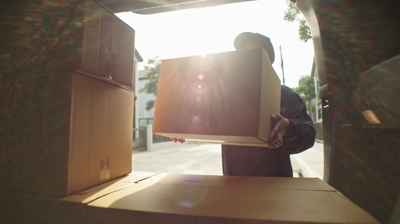
El Paso Car Accident Attorney
Injured in an Auto Accident in El Paso, TX?
Getting into a serious accident can change the course of your life. When another driver behaves recklessly, it can damage far more than just your car. Bodily injuries are almost inevitable when you mix heavy machinery and speed with human negligence, and they can have devastating consequences on everything from your job to your personal life.
When you call the Harmonson Law Firm for help, you're not just getting any attorney – you're getting the expertise of S. Clark Harmonson, who literally wrote the book on Texas auto insurance claims. His published works on accident cases for both Texas and New Mexico make him uniquely qualified to handle your case with the authority that comes from deep, specialized knowledge.
When you call the Harmonson Law Firm for help, you take the first step toward making it right and holding the responsible party or entity accountable for their wrongdoing.
Call or contact us online to speak to our El Paso car accident lawyer about your injuries and your legal options.
Why Choose an Author and Expert on Auto Accident Claims?
S. Clark Harmonson has authored comprehensive guides on auto insurance claims in Texas and New Mexico, giving him unparalleled expertise in the exact legal challenges you face. This isn't just marketing – it's documented expertise that sets our firm apart from every other attorney in the region.
Our unique qualifications include:
- Over $25,000,000 recovered for hundreds of clients in the past 10+ years
- Published author on Texas auto insurance claims
- 97% success rate in personal injury cases
- Super Lawyer designation
- Physical offices in both El Paso and Las Cruces for true local representation
Client Testimonial: "The Best Decision. My family and I were in a car accident back in 2019 and Mr. Clark and his staff did everything they could to get us taken care of. I’m extremely happy we decided to go with him. It was a lengthy process and he got the job done!" - Monica C.
Understanding Texas Car Accident Laws: A Detailed Guide
The Fault-Based System in Texas
In Texas, car accident laws operate primarily under a fault-based system, meaning the person responsible for causing the accident is also responsible for any resulting damages. After a collision, the injured party has the right to:
- File a claim with their own insurance company
- File a third-party claim with the at-fault driver's insurance provider
- Pursue a personal injury lawsuit against the driver directly
This system contrasts with "no-fault" states, where each driver typically seeks compensation from their own insurer regardless of fault.
Modified Comparative Fault Rule
Texas follows a modified comparative fault rule, also known as "proportionate responsibility." Under this rule, a driver can recover damages only if they are found to be less than 51% at fault for the accident. If the injured party is partially at fault, their compensation is reduced in proportion to their percentage of fault.
Example: If a driver is 20% responsible for an accident and is awarded $10,000 in damages, they would receive $8,000.
Required Insurance Coverage in Texas
The state mandates that drivers carry minimum liability insurance coverage, which currently includes:
- $30,000 for bodily injury per person
- $60,000 per accident
- $25,000 for property damage
This is commonly referred to as 30/60/25 coverage. Failing to carry this minimum insurance can result in fines, license suspension, and additional penalties if an uninsured driver causes an accident.
Statute of Limitations
Texas imposes a two-year statute of limitations for personal injury and property damage claims resulting from car accidents. This means victims generally have two years from the date of the accident to file a lawsuit. Missing this deadline could result in the court dismissing the case entirely, barring recovery of any compensation.
Reporting Requirements
Texas law requires that accidents involving injury, death, or significant property damage be reported to law enforcement. Drivers must remain at the scene and exchange relevant information. Fleeing the scene, commonly known as a hit-and-run, is a criminal offense and can lead to severe penalties, including fines, imprisonment, and license revocation.
El Paso's Most Dangerous Roads and Intersections
El Paso's unique geography and major transportation corridors create specific accident risks that every driver should understand:
High-Risk Areas:
- Interstate 10 - Heavy truck traffic and high speeds contribute to severe accidents
- Loop 375 (Border Highway) - Multiple lanes and merging traffic create collision risks
- US-54/Patriot Freeway - Construction zones and traffic pattern changes
- Mesa Street - High pedestrian traffic near UTEP campus
- Montana Avenue - Commercial truck traffic and multiple entry points
Common El Paso Accident Scenarios:
- Commercial truck accidents on I-10 and major freight corridors
- Border-related traffic incidents involving unfamiliar drivers
- Construction zone accidents due to ongoing infrastructure projects
- Pedestrian accidents in high-traffic commercial areas
- Intersection collisions at major crossroads during rush hour
Comprehensive Guide to Car Accident Types
- Rear-End Collisions: Occur when one vehicle crashes into the back of another vehicle, usually because the driver behind is following too closely or is not paying attention. These are among the most common accidents in El Paso traffic.
- Head-On Collisions: Happen when two vehicles crash into each other from opposite directions, often resulting in serious damage and injuries due to the combined force of the impact. These frequently occur on rural roads surrounding El Paso.
- Side-Impact Collisions (T-bone accidents): These occur when the front of one vehicle crashes into the side of another, forming a "T" shape. These accidents are common at El Paso intersections, particularly during rush hour.
- Sideswipe Collisions: Happen when two vehicles brush against each other while driving in the same or opposite direction, often caused by a vehicle drifting out of its lane. Common on I-10 and other multi-lane highways.
- Rollovers: Occur when a vehicle flips over onto its side or roof, which can be caused by sharp turns, collisions, or driving on unstable terrain. SUVs and trucks are particularly vulnerable.
- Single-Vehicle Accidents: Involve just one vehicle, often due to the driver losing control, hitting a fixed object, or running off the road. Weather conditions and road defects can be contributing factors.
- Commercial Truck Accidents: Given El Paso's position as a major shipping hub, 18-wheeler and commercial vehicle accidents are unfortunately common. These accidents often result in catastrophic injuries due to the size and weight difference.
- Pedestrian Accidents: Involve a vehicle hitting a pedestrian. These accidents are often serious, given the vulnerability of pedestrians. El Paso's downtown area and university district see higher rates of these incidents.
- Hit-and-Run Accidents: Occur when a driver involved in an accident leaves the scene without exchanging information or assisting the injured. This is a criminal offense in Texas with serious legal consequences.
- Motorcycle Accidents: Involve a motorcycle and another vehicle, often occurring due to the motorcycle being less visible or the rider losing control. They can be particularly dangerous for the rider.
Common Causes of Car Accidents in El Paso
- Distracted Driving: This is one of the leading causes of car accidents. It involves drivers taking their attention away from the road, usually due to:
- Texting or using a mobile phone
- Eating or drinking
- Talking to passengers
- Adjusting the radio or GPS
- Speeding: Driving above the speed limit reduces the driver's ability to react to unexpected situations and increases the severity of accidents. High-speed driving also reduces stopping distances, making it harder to avoid collisions.
- Drunk Driving: Alcohol and drugs impair the driver’s ability to make sound decisions, react quickly, and maintain control of the vehicle. This leads to accidents, often with serious consequences.
- Reckless or Aggressive Driving: Behaviors such as tailgating, weaving between lanes, not yielding, or overtaking other vehicles in dangerous situations can easily lead to collisions. Aggressive drivers often disregard traffic rules and safety for the sake of speed or frustration.
- Running Red Lights and Stop Signs: Disregarding traffic signals or failing to stop at stop signs can lead to accidents, especially at intersections. This is often the cause of T-bone or side-impact collisions.
- Weather Conditions: Adverse weather conditions such as rain, dust storms, fog, or strong winds can reduce visibility and traction, making it harder to control the vehicle and increasing the chances of an accident. El Paso's desert climate creates unique hazards, including sudden dust storms and monsoon conditions.
- Fatigue or Drowsy Driving: Tired drivers are less alert, have slower reaction times, and may even fall asleep at the wheel. Driving while fatigued can be as dangerous as driving under the influence of alcohol.
- Construction Zones: El Paso's ongoing infrastructure improvements create temporary hazards with changed traffic patterns, reduced lanes, and confusing signage.
Car Accident Injuries and Medical Costs
Damages caused by car accidents typically go far beyond dented bumpers and broken windows. Physical injuries are often the most painful, lasting damages you can experience in an accident, and they can affect your work, future prospects, overall health, social life, and more.
Traumatic Brain Injuries (TBI)
One of the most serious types of injuries, TBIs can result from the brain hitting the inside of the skull during impact. Symptoms may include:
- Memory loss and confusion
- Difficulty concentrating
- Personality changes
- Chronic headaches
- Long-term cognitive impairment
Long-term costs: TBI treatment can exceed $1 million over a lifetime, including ongoing rehabilitation, therapy, and specialized care.
Spinal Cord Injuries and Paralysis
Damage to the spinal cord can result in partial or complete paralysis. These catastrophic injuries require:
- Emergency surgery
- Extended hospital stays
- Lifetime medical care
- Home modifications
- Specialized equipment
Long-term costs: Spinal cord injuries can cost $2-4 million over a patient's lifetime.
Neck and Back Injuries
Including whiplash, herniated discs, and fractures. These injuries often require:
- Physical therapy
- Chiropractic care
- Pain management
- Potential surgery
Internal Injuries
Damage to internal organs, internal bleeding, and traumatic cardiac arrest can be life-threatening and require immediate emergency treatment.
Broken Bones and Fractures
From simple breaks to compound fractures requiring:
- Emergency room treatment
- Orthopedic surgery
- Physical rehabilitation
- Long-term care
Burns and Scarring
Severe accidents can cause burns from fires or heated metal, resulting in:
- Skin grafts
- Plastic surgery
- Ongoing wound care
- Psychological counseling
Common auto accident injuries that you can be compensated for include:
- Nerve damage
- Burns and scars
- Soft tissue injuries
- Traumatic cardiac arrest
- Neck, back, and spine fractures
- Torn ligaments and tendons
- Traumatic brain injuries
- Penetrative wounds
- Internal bleeding
- Amputation
- Paralysis
- Death
Understanding Your Legal Rights and Compensation
Types of Damages Available
Economic Damages (Quantifiable Financial Losses):
- Medical expenses (past and future)
- Lost wages and earning capacity
- Property damage
- Rehabilitation costs
- Home and vehicle modifications
- Ongoing care costs
Non-Economic Damages (Subjective Losses):
- Pain and suffering
- Emotional distress
- Loss of enjoyment of life
- Loss of consortium
- Mental anguish
- Permanent disability or disfigurement
Punitive Damages (Rare Cases): Available only when the at-fault party's conduct was particularly egregious, such as drunk driving or extreme recklessness.
Financial Impact: The True Cost of Car Accident Injuries
As you may already have experienced, such injuries come with a hefty price tag. Common expenses and losses associated with car accident injuries include:
- Hospital bills
- Outpatient rehabilitation
- Long-term disability costs
- Cost of medications and treatment
- Lost wages due to time spent out of work
- Loss of employment or job possibilities
- Long-term care for lifelong damages
- Loss of consortium
- Anesthesia
- Surgery
These are just the tip of the iceberg. If your injuries create permanent changes in your abilities or quality of life, or if they require long-term treatment, your medical costs could ultimately cost you millions of dollars. At Harmonson Law Firm, we believe that you shouldn't be left to foot the bill when someone else makes poor decisions while behind the wheel of a car—and we are here to help you get the compensation you need. Even if your injuries do not come to light until later on, you can still take legal action against the driver who hit you.
What is the Car Accident Claim Process in TX?
Your El Paso car accident lawyer will start the process by investigating who is at fault, then will talk to you and your physicians to determine what your claim is worth in terms of medical expenses, lost wages, and pain and suffering. If you are expected to continue to have medical bills and lost wages for a significant length of time your attorney will calculate those costs, along with your pain and suffering costs.
Step-by-Step Process:
- Initial Investigation
- Obtain and review the accident report
- Interview witnesses
- Photograph the accident scene
- Inspect vehicles involved
- Consult with accident reconstruction experts if needed
- Medical Documentation
- Compile all medical records and bills
- Work with treating physicians to document injuries
- Obtain expert medical opinions on future treatment needs
- Insurance Communications
- Send demand letter to at-fault driver's insurance company
- Notify your own insurance company of potential coverage
- Handle all communications with insurance adjusters
- Negotiation Phase
- Present comprehensive demand package
- Negotiate fair settlement terms
- Advise on whether to accept or reject offers
- Litigation if Necessary
- File lawsuit if fair settlement cannot be reached
- Conduct discovery process
- Prepare for trial
- Continue settlement negotiations through trial
A demand letter will then be sent to the at-fault driver's insurance company. Rarely will an insurer agree immediately to pay the full amount. Your attorney will enter into negotiations with the insurer and if no agreement can be reached, a lawsuit will be filed against the insurance company. Even after a lawsuit is filed, the insurance company has until right before the jury reaches a verdict to offer a fair settlement. Otherwise, the decision will be up to the jury. Once a settlement agreement or jury verdict is reached, you should receive your check for damages within about six weeks of the decision.
Do I Have a Auto Accident Case?
The best way to determine whether you have a valid car accident claim is to speak to a knowledgeable El Paso car accident attorney. An experienced attorney can comprehensively investigate your accident, determining fault and calculating your injuries and damages. If the attorney you speak to doesn’t feel that filing a claim has much chance of success, he or she will tell you this. In cases where the plaintiff shares a significant amount of the liability or has very minor injuries, filing a car accident claim might not be feasible.
You likely have a strong case if:
- Another driver was clearly at fault
- You sustained significant injuries requiring medical treatment
- You have documented financial losses (medical bills, lost wages)
- The accident was properly reported to police
- You are less than 51% at fault under Texas law
Act today by calling to speak to our El Paso auto accident attorneys.



From Injury to Recovery FAQ's to Help Start Your Journey
-
What rights do I have following my car accident?If you sustain significant injuries in an accident, you should call 911 and go to the emergency room as soon as possible after a car accident. The hospital must treat you regardless of your financial ability to pay and even if you do not have health insurance. This is important to know, as a significant… CONTINUE READING
-
Is a driver at fault for an accident when a pedestrian is in or near a crosswalk?The fact that a pedestrian is in or near a crosswalk does not mean that the other driver is automatically responsible for the pedestrian’s injuries. Pedestrians are always required to obey all traffic signals. If a pedestrian enters the crosswalk when not allowed, the other driver may be able to either wholly or partially escape…CONTINUE READING
-
What is negligence and does it play a role in my car accident?Negligence is a legal term and is defined as failing to do that which a person of ordinary prudence would have done under the same or similar circumstances. Negligence also means doing that which a person of ordinary prudence would not have done under the same or similar circumstances. When a driver’s negligence causes another…CONTINUE READING
-
What information do I need to gather at the scene of a car accident?Gather as much information as possible about the other driver, including the driver’s name, address, telephone number, driver’s license number, and insurance information. Take photos of your vehicle and the other driver’s vehicle. If you have cuts, bruises, or other injuries and are in shape to take photos, do so. Also, get the name, address…CONTINUE READING
-
What should I do if I was involved in an auto accident?Immediately after an accident, stop, don’t leave the scene, and make sure everyone is okay. If there are injuries, the first call you should make is 911. You should always call the police in the event of an accident, cooperate, and be respectful to the police and the other driver. Gather as much information as…CONTINUE READING
Stay Informed News, Tips, & Advice
Want all the latest news or updates? Browse through our blog to read our most recent posts and featured articles.


